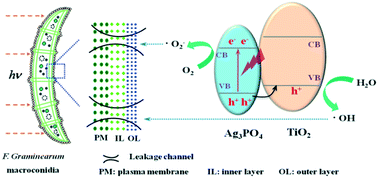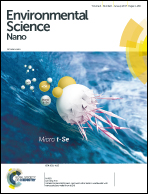Visible-light-driven TiO2/Ag3PO4 heterostructures with enhanced antifungal activity against agricultural pathogenic fungi Fusarium graminearum and mechanism insight†
Abstract
A series of TiO2/Ag3PO4 heterostructures were fabricated via a facile in situ precipitation process. The as-synthesized composites were found to exhibit markedly enhanced photocatalytic inactivation of E. coli under visible light irradiation compared with bare TiO2 and Ag3PO4 owing to the improved light absorption and the efficient separation of photo-induced electron–hole pairs. Moreover, the antifungal activity of the composite materials was studied against the phytopathogen Fusarium graminearum (one of the main pathogens of wheat). With 100 min of visible light illumination, the TiO2/Ag3PO4 composite reduced the survival ratio of the F. graminearum macroconidia to about 2%. The photocatalytic disinfection mechanism of the macroconidia was attributed to the damage to their cell wall/membrane caused by the attack of reactive oxygen species as demonstrated by fluorescence staining. In addition, ESR measurement revealed that hydroxyl radicals were the predominant active species in the photocatalytic disinfection system. Our results suggest that this hybrid photocatalyst has great potential as an environmentally-friendly alternative method to disinfect plant pathogens for agricultural areas.


 Please wait while we load your content...
Please wait while we load your content...